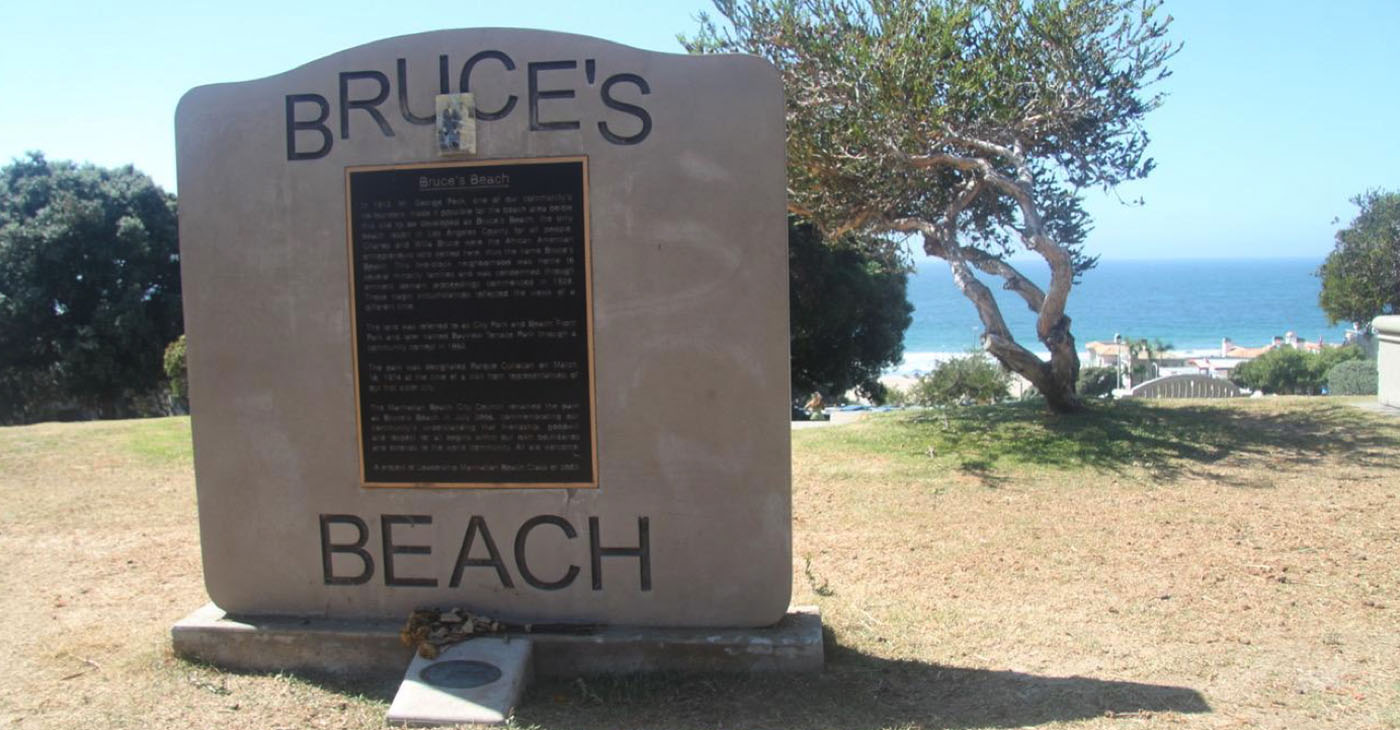Black History
Heirs of Bruce’s Beach Finalize Sale of Property Back to LA County
On Jan. 30, the heirs of Bruce’s Beach finalized the sale of the land they just reclaimed last year back to Los Angeles County for $20 million. But the news of the sale was somewhat disappointing for those who reveled in the victory of justice carried out more than 100 years and hoped the Bruce family would keep the property in the family.

By Antonio Ray Harvey
California Black Media
On Jan. 30, the heirs of Bruce’s Beach finalized the sale of the land they just reclaimed last year back to Los Angeles County for $20 million.
The Bruce Family’s attorney George C. Fatheree III told KBLA radio personality Tavis Smiley that the family was prompted to sell because it faced a long and drawn-out process to get approval for development by the city of Manhattan and the California Coastal Commission.
“The return of the property and the ability to sell the property and take funds and invest it in a way that’s important to their lives represents an important opportunity for my clients to get a glimpse of that legacy that was theirs,” Fatheree said.
But the news of the sale was somewhat disappointing for those who reveled in the victory of justice carried out more than 100 years and hoped the Bruce family would keep the property in the family.
Antonio Moore, a Los Angeles attorney, and co-founder of the American Descendants of Slavery (ADOS) movement, says the deal reached by the heirs of Bruce’s Beach “doesn’t seem to be at fair market value.”
In his Jan. 6 podcast, which can be viewed on Youtube, Moore said he crunched the real estate numbers of surrounding property in Manhattan Beach and claims that the land is worth more than the $20 million — the price at which the heirs of the controversial property were offered for the land.
The attorney said the option to sell back the land, which was first purchased in 1912 and illegally acquired by the city, is akin to the financial loss Black Americans have experienced over the decades due to “housing discrimination.”
“In essence, we are going to give them back the property but not assess any of the generational costs,” he said. “And then we (the county of Los Angeles) are going to create all types of limitations on the way they can access and use that property.”
Moore continued by saying, “The fact that this was sold back for $20 million should have everyone in an uproar. The fact that the (California) Reparations Task Force has literally said nothing about this is abject failure in my view.”
In his 37-minute podcast, Moore said that no one really took the time to “contextualize” the agreement between the county and the Bruce family since the announcement was made. Houses and condos around Bruce’s Beach are priced at around “$3 or $4 million,” he said.
According to Realtor.com, Manhattan Beach in Los Angeles County consists of five neighborhoods. As of Jan. 22, there were 57 homes for sale, ranging from $1.2 million to $22 million.
As of July 1, 2022, 34,668 people resided in the beach town located about 30 miles southwest of Los Angeles. Of that number, 74.8% are white and 0.5% are Black, according to U.S. Census Bureau numbers.
“I am not here to attack this family,” Moore said of the Bruce family. “I am more so here to question how we got here.”
The disturbing story of Bruce’s Beach Park — the location of the first West Coast seaside resort for Black beachgoers and a residential enclave for a few African American families — has received worldwide attention.
One hundred years ago, Manhattan Beach city officials seized Charles and Willa Bruce’s beachfront property through eminent domain, citing an “urgent need” to build a city park.
The use of eminent domain was the end result of segregation, intimidation, violence and threats from the Ku Klux Klan in Manhattan Beach. The plot of land that attracted Black people from all over the country was not developed for recreational use after it was forcefully taken from the Black owners.
On April 9, 2021, Los Angeles County Supervisor Janice Hahn announced the return of the land to the Bruce’s descendants. The Bruces had purchased the real estate in 1912 for $1,225.
The transfer of ownership of the land was completed with the help of legislation authored by state Sen. Steven Bradford (D-Gardena). Senate Bill (SB) 796 exempted the Bruce’s Beach property from state zoning and development restrictions and enabled the county to return the site to its rightful owners.
On Sept. 30, 2021, Gov. Gavin Newsom signed off on SB 796, allowing the Bruce family to retain the property which had appreciated in value over the last century.
The heirs had two options. LA County was in line to lease the land for $413,000 per year. It also included an exchange to buy the land for as much as $20 million. The family took the latter.
After the news of the decision to sell the land back to the county broke, social media exploded with commentaries from the Black community — for and against the sale.
Opinions on Twitter ranged from, “they got hustled,” the family “knew they’d sell back the property due to taxes,” “I wish they could have reached out to grass roots for direction and assistance,” “sad,” “unbelievable,” to “This was theirs to sell in the first place. Why are we acting like this was ours?”
Holly J. Mitchell, L.A. County Supervisor for the Second District, stated in a Jan. 3 press release that she was “proud” that the county and state addressed the “systematic racist acts that have cost Black families generational wealth.”
“I fully support the self-determination of Black people and families like the Bruces to decide what is best for their lives and legacy,” Mitchell said. “I will continue to advocate for the Bruce family to be fully informed and prepared for the immediate and long-term implications of this sale.”
Considering the well-documented history of racism in housing and real estate that have affected Black Californians, Bruce’s Beach draws attention to other areas in the state where discriminatory laws or practices that have caused Blacks to be illegally displaced or to lose valuable property. Many of these incidents have been highlighted by the California reparations task force.
Examples include land once owned by Black pioneers in Coloma, where the Gold Rush started in 1848; the removal of African Americans from their homes in downtown Santa Monica; and Black community loss of property in Russell City, located between Hayward and Oakland.
“The return of Bruce’s Beach to the rightful heirs of Charles and Willa Bruce will continue to serve as an example of what is possible across the globe when you have the political will and leadership to correct the injustices of the past,” Mitchell added.
Activism
Oakland Post: Week of April 17 – 23, 2024
The printed Weekly Edition of the Oakland Post: Week of April 17 – 23, 2024

To enlarge your view of this issue, use the slider, magnifying glass icon or full page icon in the lower right corner of the browser window. ![]()
Black History
Matthew Henson: Explorer Extraordinaire
Matthew Henson, a trailblazing explorer who overcame countless obstacles to leave an incredible mark on history. Born on August 8, 1866, in Charles County, Maryland, his journey is a testament to the power of determination and the spirit of adventure.

By Tamara Shiloh
Matthew Henson, a trailblazing explorer who overcame countless obstacles to leave an incredible mark on history. Born on August 8, 1866, in Charles County, Maryland, his journey is a testament to the power of determination and the spirit of adventure.
Henson’s life began amidst the backdrop of post-Civil War America, where opportunities for African Americans were scarce. From a young age, he possessed an insatiable curiosity about the world beyond his small town. At the age of 12, he embarked on a journey that would change the course of his life forever when he joined a merchant ship as a cabin boy.
His most famous expedition was his journey to the Arctic with renowned explorer Robert E. Peary. In 1887, Henson joined Peary’s crew as a seaman and quickly proved himself to be invaluable with his skills as a navigator and craftsman. Over the course of several expeditions, Matthew endured extreme cold, treacherous terrain, and grueling conditions as he and Peary sought to reach the elusive North Pole.
In 1908–09, Peary set out on his eighth attempt to reach the North Pole. It was a big expedition, with Peary planning to leave supplies along the way. When he and Henson boarded their ship, the Roosevelt, leaving Greenland on August 18, 1909, they were joined by a large group. This included 22 Inuit men, 17 Inuit women, 10 children, 246 dogs, 70 tons of whale meat, blubber from 50 walruses, hunting gear, and tons of coal.
In February, Henson and Peary left their anchored ship at Ellesmere Island’s Cape Sheridan, along with the Inuit men and 130 dogs. They worked together to set up a trail and supplies along the way to the Pole.
Peary picked Henson and four Inuit people to join him in the final push to the Pole. However, before they reached their destination, Peary couldn’t walk anymore and had to ride in a dog sled. He sent Henson ahead to scout the way. In a later interview with a newspaper, Henson recalled being in the lead and realizing they had gone too far. The group turned back, and Henson noticed his footprints helped guide them to their destination. At that location, Henson planted the American flag.
Henson’s legacy extends far beyond his expeditions to the Arctic. He shattered racial barriers in the world of exploration and inspired countless individuals, regardless of race, to dream big and pursue their passions. In 1937, he was finally recognized for his achievements when he was inducted into The Explorers Club, an organization dedicated to promoting scientific exploration and field research.
Matthew Henson died in the Bronx, New York, on March 9, 1955, at the age of 88.
Art
Marin County: A Snapshot of California’s Black History Is on Display
The Marin County Office of Education, located at 1111 Las Gallinas Ave in San Rafael, will host the extraordinary exhibit, “The Legacy of Marin City: A California Black History Story (1942-1960),” from Feb. 1 to May 31, 2024. The interactive, historical, and immersive exhibit featuring memorabilia from Black shipyard workers who migrated from the South to the West Coast to work at the Marinship shipyard will provide an enriching experience for students and school staff. Community organizations will also be invited to tour the exhibit.

By Post Staff
The Marin County Office of Education, located at 1111 Las Gallinas Ave in San Rafael, will host the extraordinary exhibit, “The Legacy of Marin City: A California Black History Story (1942-1960),” from Feb. 1 to May 31, 2024.
The interactive, historical, and immersive exhibit featuring memorabilia from Black shipyard workers who migrated from the South to the West Coast to work at the Marinship shipyard will provide an enriching experience for students and school staff. Community organizations will also be invited to tour the exhibit.
All will have the opportunity to visit and be guided by its curator Felecia Gaston.
The exhibit will include photographs, articles and artifacts about the Black experience in Marin City from 1942 to 1960 from the Felecia Gaston Collection, the Anne T. Kent California Room Collection, The Ruth Marion and Pirkle Jones Collection, The Bancroft Library, and the Daniel Ruark Collection.
It also features contemporary original artwork by Chuck D of the Rock and Roll Hall of Fame group Public Enemy, clay sculptures by San Francisco-based artist Kaytea Petro, and art pieces made by Marin City youth in collaboration with Lynn Sondag, Associate Professor of Art at Dominican University of California.
The exhibit explores how Marin City residents endured housing inequities over the years and captures the history of plans to remove Black residents from the area after World War II. Throughout, it embodies the spirit of survival and endurance that emboldened the people who made Marin City home.
Felecia Gaston is the author of the commemorative book, ‘A Brand New Start…This is Home: The Story of World War II Marinship and the Legacy of Marin City.’ Thanks to the generous contribution of benefactors, a set of Felecia’s book will be placed in every public elementary, middle, and high school library in Marin.
In addition, educators and librarians at each school will have the opportunity to engage with Felecia in a review of best practices for utilizing the valuable primary sources within the book.
“Our goal is to provide students with the opportunity to learn from these significant and historical contributions to Marin County, California, and the United States,” said John Carroll, Marin County Superintendent of Schools.
“By engaging with Felecia’s book and then visiting the exhibit, students will be able to further connect their knowledge and gain a deeper understanding of this significant historical period,” Carroll continued.
Felecia Gaston adds, “The Marin County Office of Education’s decision to bring the Marin City Historical Traveling Exhibit and publication, ‘A Brand New Start…This is Home’ to young students is intentional and plays a substantial role in the educational world. It is imperative that our community knows the contributions of Marin City Black residents to Marin County. Our youth are best placed to lead this transformation.”
The Marin County Office of Education will host an Open House Reception of the exhibit’s debut on Feb. 1 from 4 p.m. – 6 p.m.. All school staff, educators, librarians, and community members are encouraged to attend to preview the exhibit and connect with Felecia Gaston. To contact Gaston, email MarinCityLegacy@marinschools.org
-

 Activism4 weeks ago
Activism4 weeks agoOakland Post: Week of March 20 – 26, 2024
-

 #NNPA BlackPress3 weeks ago
#NNPA BlackPress3 weeks agoCOMMENTARY: D.C. Crime Bill Fails to Address Root Causes of Violence and Incarceration
-

 #NNPA BlackPress4 weeks ago
#NNPA BlackPress4 weeks agoFrom Raids to Revelations: The Dark Turn in Sean ‘Diddy’ Combs’ Saga
-

 #NNPA BlackPress3 weeks ago
#NNPA BlackPress3 weeks agoMayor, City Council President React to May 31 Closing of Birmingham-Southern College
-

 #NNPA BlackPress4 weeks ago
#NNPA BlackPress4 weeks agoCOMMENTARY: Lady Day and The Lights!
-

 Activism3 weeks ago
Activism3 weeks agoOakland Post: Week of March 27 – April 2, 2024
-

 #NNPA BlackPress4 weeks ago
#NNPA BlackPress4 weeks agoBaltimore Key Bridge Catastrophe: A City’s Heartbreak and a Nation’s Alarm
-

 #NNPA BlackPress4 weeks ago
#NNPA BlackPress4 weeks agoBaltimore’s Key Bridge Struck by Ship, Collapses into Water














































